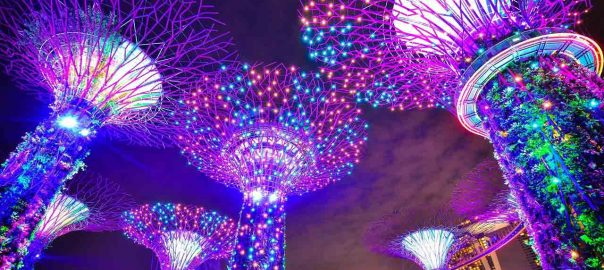Our trees make our landscapes come alive. We cherish them, tend to their needs by purchasing special fertilizers or contacting a professional tree surgeon when in need of expert advice. Indeed, these majestic creations are the masters of our outdoor landscape. Considering how much we love our trees, we often forget them at night, yet that is when they can convey their most haunting beauty. These monuments to nature, stationary columns of bark and brawn, crowned beautifully with an abundance of leaves become absolute works of art when properly lit with affordable, outdoor solar lighting, such as what you’d find at White Stores. If this idea captivates you, then allow us to help give you a start when it comes to lighting your very, own trees.
The Importance of Balance and Preparation
It’s a good idea to take a few guidelines under consideration when you set out to create the perfect, nighttime atmosphere in your flower garden. While it’s true that creativity is welcomed, if it does not have a proper plan, then the results could be a nightmare. For instance, one of the most common mistakes people make is to just rush to the store and purchase a light for every tree, as doing this can just create a mass of erratically placed, messy lighting, to where the light becomes a distracting element with regards to the trees themselves. To avoid this cacophony of lights, think in terms of balance, this way you’ll not end up with unsightly clumps of lighting interspersed with dark spaces.
Go out with a notepad, and conscientiously think which trees you’d like to light first. Keep in mind that when you illuminate your trees at night, you’ll be seeing a new aspect of your trees, crevices, and branch patterns that evade you during the daylight. To help you in attaining balance, go outside the night before you install your lights. Bring a flashlight with you, and simply begin to illuminate various trees at different angles to get a good idea of what effect you might want to achieve. Perhaps there are some trees which you do not wish to light, perhaps there are others which you’d like to place two lights near. Also, match the size of the tree with the size of the solar light. A large weeping willow may require a large spotlight, whereas a small, freestanding tree of 10 feet or less, may require a smaller stake light.
Uplighting to Expose the Statuesque Beauty of Your Trees At Night
When you uplight your selected tree or flower tree, look for a stake mounted outdoor solar light. They are simple to install, just stake them into the ground where the uplighting effect will have the most appeal. For example, perhaps the tree has a unique twist to the trunk, and you’ll like to highlight that, simply stake the light into the ground, near the trunk, and position the lamp upwards. If you’re new to this, don’t fret. it’s actually okay for this to take several attempts before you get it right. Just keep in mind that you need to position these staked solar lights out of the way of any paths, so guests don’t trip over them. If you have a very large, robust trees, such as ash or oak, you may consider using a flood or large spotlight in order to capture the intricacies of its trunk and canopy. Uplighting is perfect for the Platanus type trees, where their shape is reminiscent of an umbrella, these include:
- American Sycamore
- Western Sycamore
- Platanus Orientalis
Remember, your professional arborist is there to help you. If you can’t decide which tree to illuminate, or how, simply make an appointment for an arborist to assist you in determining which trees would benefit most or which to leave out.
Floodlights to Add Drama, Shadows, or Silhouette Effects
Whereas in uplighting, you place the spotlight at the base of the trunk, with floodlights, you can place it in the tree or flowering plants to create a downlighting effect. This is not something we recommend you do on your own, so have someone to spot you. First, find a location where the branches are sturdy, and won’t move so much if the wind starts to roll in. Place the floodlight facing down through the tree so you’ll be able to highlight the trees’ unique branch patterns as well as create interesting shadows and lighting effects on the path below. If you have an extra-large tree, floodlights can be placed farther from the trunk, capture the full-frontal beauty, or behind the tree to create a shadowy, silhouette effect.
Large LED Sphere Lights Highlight the Magical, Ethereal Beauty of Your Trees
These are an interesting and creative addition to your flower garden and can be used to create an ethereal, eerie effect between trees by connecting them with light at the ground level. For instance, if you are using uplighting to highlight the trunk and canopy of your trees, you can place a few of these waterproof LED ball lights in dark areas between them. While the uplighting connects the trees from above via their canopy’s, the ball lights can be strategically placed in between the trees, which also eliminates the unsightly appearance of dark, unlit spaces, and in effect, creating a continuous environment of gentle, soft garden lighting which connects each tree. If you have a water feature, pool, or pond, know that you can place these waterproof, floating LED spheres on the water, and allow their light to reflect softly on the surrounding trees.
Final Thoughts On Tree Lighting
No matter what type of lighting you use, take extra care that the lights do not shine into traffic, or your neighbours’ homes, keep them on the trees where they belong. Lighting your trees or flowering plants is simple once you prepare a plan, purchase the proper lighting for the effect you wish to achieve, and spend some time adjusting the placement and angles of each light. Lighting your trees not only adds beauty but creates much-needed lighting for walkways and also gives you that extra bit of security you need during the night time hours. If you have any questions regarding how to properly illuminate different types of trees, we suggest talking to your arborist who’ll be more than happy to give you a hand







